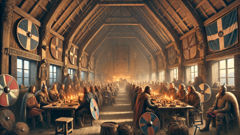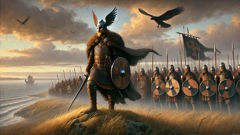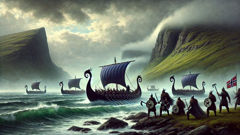Introduction
In the far northern reaches of the British Isles, where the North Sea’s restless grey meets the wild Atlantic, lie the Orkney Islands—a scatter of green and stone on the ragged edge of the world. For centuries, the gales have lashed these rocky shores and painted the sky with shifting cloud and radiant light. It is a land where time seems to pause, where the wind carries the voices of long-dead Norsemen and the stones whisper secrets of ancient kings. When the ninth century dawned, these islands were already old, their low hills and brooding cliffs shaped by the hands of forgotten ancestors. Here, Pictish forts crumbled on the headlands and mysterious stone circles kept silent vigil. But change was coming. From across the sea, a new tide swept in—fierce men with braided beards and iron blades, hungry for land, glory, and a place to call their own. The Orkneyinga Saga was born not in ink but in fire and blood: stories passed from one fireside to another, tales of conquest, kinship, and the struggle for power. Through the centuries that followed, the islands would serve as both prize and battleground, a crossroads for cultures and ambitions. Norwegian kings and Scottish lairds, Viking jarls and native chiefs—all would leave their mark upon Orkney’s stones. From Harald Fairhair’s first fleet to the last Norse earl, this saga charts the rise and fall of men whose names are etched into the very bones of the islands. Their deeds echo in winds that never rest and seas that never sleep, a reminder that on the edge of the world, courage and cunning are as vital as breath. As you step into this story, listen for the ancient voices. The Orkneyinga Saga is more than history—it is the heart of a people forged by salt, wind, and stone.
The Coming of the Northmen
The Orkney Islands in the ninth century were a patchwork of petty Pictish kingdoms. Small farms clung to the thin soil, and fishermen’s boats danced in sheltered bays. Stone brochs and turf-roofed dwellings dotted the land, their inhabitants ruled by ancient traditions and the shifting alliances of chieftains. Life was hard but steady, until the horizon filled with dragon-prowed ships and the world changed forever.

Harald Fairhair, young and determined, sought to unite Norway under his crown. Yet, as he tightened his grip, many Norsemen—jarls and warriors unwilling to bend their knee—fled westward. They came as raiders at first, striking swiftly along the Scottish and Irish coasts. But soon, they hungered for more than plunder. Orkney, with its green pastures, abundant seal colonies, and sheltered anchorages, beckoned as a place to rule.
The first Norsemen arrived in waves, their longships threading the rocky inlets and skerries. Stories say it was Rognvald Eysteinsson, Earl of Møre and a loyal ally of King Harald, who received Orkney and Shetland as compensation for the loss of his son. Rognvald, wise in council and fierce in battle, sent his brother Sigurd to claim the islands. Sigurd the Mighty—so he would be called—landed at the Bay of Skaill, his men sweeping through villages and fortresses with ruthless efficiency. The old Pictish chiefs fell before his sword, their stones toppling as new masters raised wooden halls beside ancient circles.
Sigurd ruled with iron and insight, forging alliances with Scottish chieftains on the mainland and extending his reach across Caithness. His rule was not uncontested. The land itself seemed to resist, and the very sea was a test of resolve. On windswept cliffs, the new Norse lords built strongholds of turf and timber, their halls filled with the smell of peat smoke and brine. Skalds sang of the conquest by firelight, their verses echoing through the winter darkness.
Yet Sigurd’s story, like so many in Orkney’s saga, ended in a twist of fate. In battle against a rival—Máel Brigte the Bucktoothed—Sigurd won the day and tied his enemy’s head to his saddle as a trophy. But the dead man’s tooth cut his leg, and infection brought Sigurd low. The islands mourned, for even the mighty fall prey to chance. With Sigurd’s death, new claimants emerged. The islands became a chessboard for ambitious jarls and distant kings. Power shifted as quickly as the northern weather. Some sought peace with local Picts and Scots; others imposed rule by sword alone.
Despite the violence and upheaval, Norse culture took root. Old gods mingled with Christian saints, runes carved beside crosses. The land itself began to change: new fields were ploughed, harbors improved, and villages grew under the watchful gaze of the earls’ hall. The saga’s first chapter closed with Orkney firmly in Norse hands, yet already shaped by many voices—Pictish ghosts, Scottish neighbors, and Norse adventurers. The next generations would not inherit peace but a legacy of ambition, rivalry, and an island people forged from many worlds.
The Age of the Earls: Power, Feud, and Faith
As decades passed, the Norse grip on Orkney tightened and the islands flourished under a lineage of jarls—each one both ruler and warrior, often torn by rivalry as fierce as any storm. The Orkneyinga Saga remembers these centuries not as an age of peace, but as a restless dance of ambition, betrayal, and fragile alliances.

Earl Thorfinn Skullsplitter—son of Torf-Einar, himself a legendary earl—became synonymous with cunning and ferocity. Under Thorfinn, Orkney grew into a power that reached into northern Scotland and the Hebrides. His sons, however, turned from brothers to bitter foes. The saga is rich with tales of poison in goblets, treacherous feasts in smoky halls, and skirmishes fought at dawn among standing stones. Every earl dreamed of ruling alone, but Orkney’s fate was ever entwined with kin.
No tale better reveals the nature of these feuds than the saga of Earl Sigurd Hlodvirsson—Sigurd the Stout—who ruled at the turn of the first millennium. Sigurd was a man of vision, building churches as well as ships, and balancing pagan tradition with the advance of Christianity. His banner, woven with the raven of Odin, flew at the Battle of Clontarf, where Norsemen and Irish kings clashed in one of medieval Europe’s great showdowns. Sigurd fell that day in Dublin’s green fields, his blood mixing with thousands of others—Christian and pagan, friend and foe. His death marked a turning point.
In the generations that followed, Christianity’s hold grew stronger. The mighty St. Magnus Cathedral began as the dream of Earl Rognvald Kali Kolsson, a noble who valued both the sword and the lyre. The cathedral’s red sandstone walls still rise over Kirkwall, a monument to faith and a legacy carved in stone. Rognvald himself traveled to Jerusalem, crusading not for gold but for honor and penance—a rare light amid the violence.
Yet even faith could not tame Orkney’s wild heart. Blood feuds persisted. The saga tells of Magnus Erlendsson, a gentle earl renowned for his piety and wisdom, who refused to fight at the Battle of Menai Strait. Betrayed by his own cousin Hakon, Magnus was martyred on Egilsay’s lonely shore, his sanctity inspiring pilgrimage for centuries. Orkney’s people mourned, but survival demanded hard choices. Kinship was both shield and sword.
Amid these cycles of rivalry, the islands grew. Norse law governed trade and settlement. Farmers turned the soil, fishermen braved stormy seas, and skalds sang new verses beside old hearths. The saga’s heart beats in these stories—a world where faith and family shaped every ambition, and every gain was balanced by loss.
Twilight and Transformation: The End of Norse Rule
By the twelfth century, Orkney’s saga was entering its final Norse chapter. The great earls ruled over an island world increasingly pulled between Norway’s distant court and Scotland’s rising ambitions. Borders blurred on maps and in hearts, as Norse tradition met Gaelic influence in marriage, language, and law.

Earl Harald Maddadsson embodied this new world. Born of a Norse father and a Gaelic mother, he ruled for nearly half a century—longer than any before him. Harald’s reign was marked by constant negotiation: with Norwegian kings who claimed him as vassal, with Scottish monarchs eager to extend their reach, and with restless island chieftains who measured loyalty in cattle and land. His court was a crossroads of cultures—Norse sagas recited in smoky halls, Gaelic harpers singing beside the fire, priests debating faith and law.
Yet power was always precarious. Norwegian kings like Magnus Barefoot sent fleets across the sea to remind Orkney’s earls of their obligations. Sometimes they brought gifts; more often, war. Scottish kings pressed from the south, offering alliances sealed by marriage or threats. The islands’ fate hung in the balance, determined as much by diplomacy as by sword.
As the thirteenth century neared, Norse power waned. Magnus Erlingsson, last king to claim Orkney outright, saw his authority challenged by both island lords and the Scottish crown. The saga closes with the Treaty of Perth in 1266—a quiet agreement that signaled the islands’ gradual shift under Scottish sway. The Norse earls became part of memory, their stone-built halls falling into ruin or absorbed by new masters.
But what survived was not just names or titles. The Norse spirit lingered: in the dialects spoken on windblown farms; in the standing stones and churches; in the stubborn independence of Orkney’s people. The saga’s final lines are written not in blood but in resilience—a world transformed, but never fully conquered.
Conclusion
The story of the Earls of Orkney is more than a chronicle of conquest and rivalry; it’s a testament to the endurance of a people shaped by sea and stone. Across four centuries, Norsemen came as invaders but became islanders—building farms, forging families, and blending traditions until Orkney belonged to none but itself. The old sagas linger still in winds that roar off Hoy’s cliffs and the quiet hush of cathedral stones at Kirkwall. Each generation reinterprets the past: the courage of Sigurd the Mighty, the faith of St. Magnus, the ambition and adaptability of Harald Maddadsson. Their stories teach that power is fleeting but legacy endures. Today, as waves break against ancient headlands and gulls cry over green fields, Orkney’s spirit remains—resilient, independent, and alive with memories of Norse kings, Scottish lairds, and generations of islanders who called this place home.













